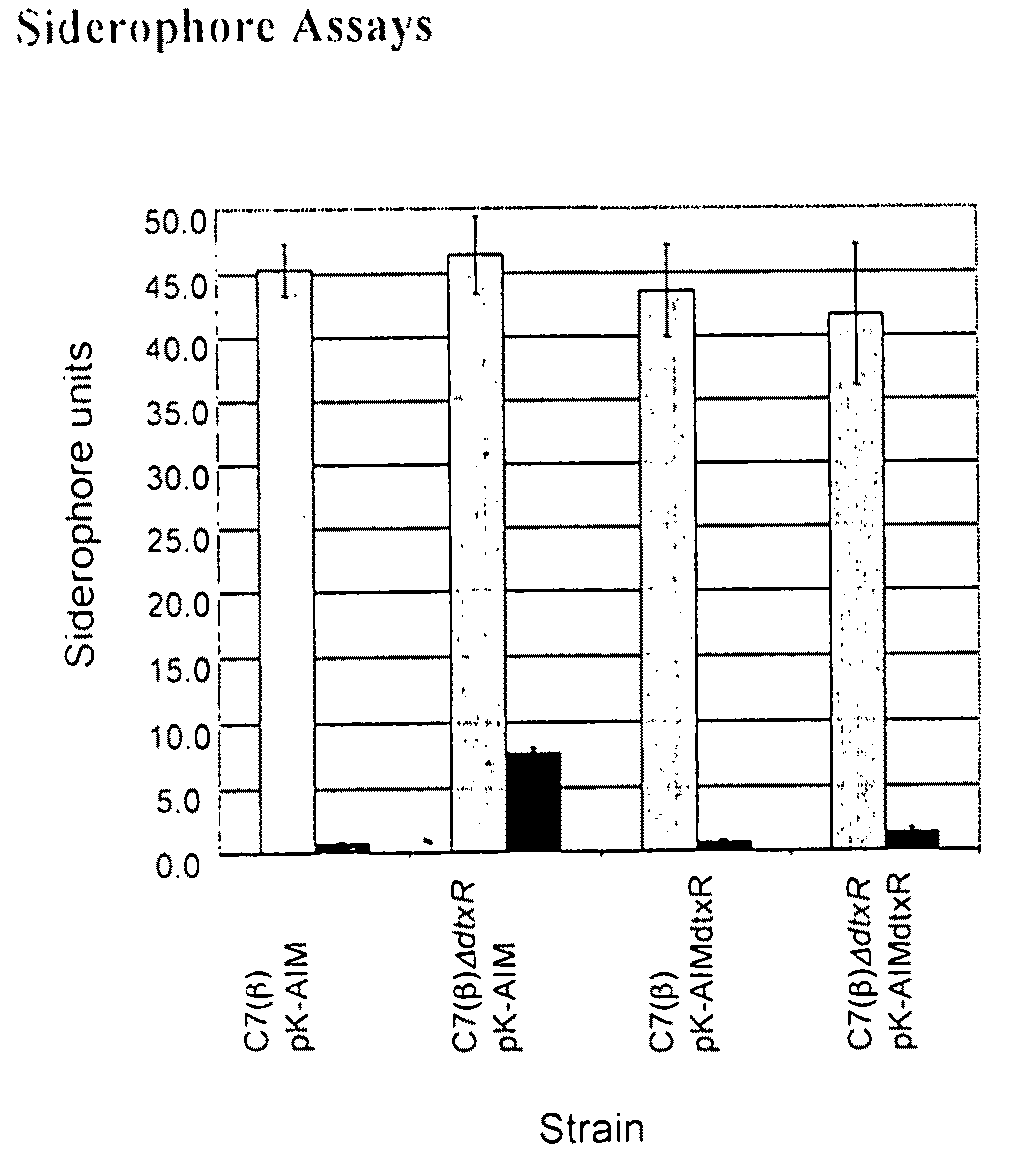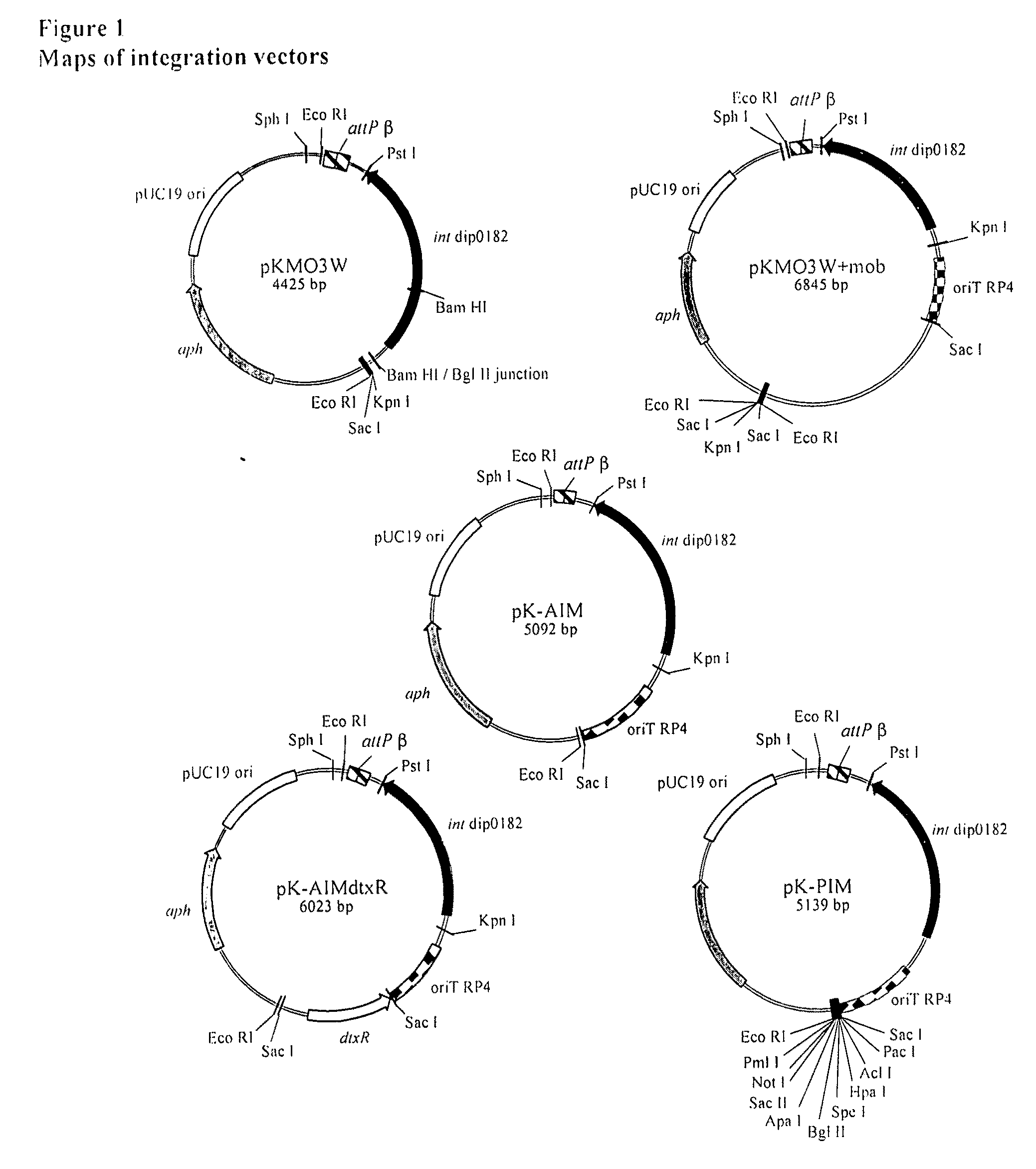Corynephage integrase-based site-specific insertion vector system
a site-specific insertion vector and integrase technology, applied in the field of corynephage integrase-based site-specific insertion vector system, can solve the problems of induction of dt, inability to define and target the dna of i, and the rise of diphtheria. a significant health threat, and achieve the effect of easy mapping
- Summary
- Abstract
- Description
- Claims
- Application Information
AI Technical Summary
Benefits of technology
Problems solved by technology
Method used
Image
Examples
example 1
Corynephage β Integration Functions and Construction of pKMO3W
[0067]The two attB sites for phage β (and closely related phages) in the C. diphtheriae chromosome are each partly contained within a duplicated tRNAARG gene (anticodon ACG) (Ratti et al., 1997, Mol. Microbiol. 25, 1179-1181); a property shared with many other integrating phage systems (Campbell, 1992, J. Bacteriol. 174, 7495-7499). The sites, which are named attB1 and attB2, flank gene DIP0179 (with the numbering based on the genome annotation of C. diphtheriae strain NCTC13129 (Cerdeno-Tarraga et al, 2003, supra)) such that the genetic loci in this region map in the order DIP0178-attB2-DIP0179-attB1. The acquisition of the tox gene (DIP0222) responsible for the toxigenic nature of NCTC13129 likely occurred as a result of integration of a β-like phage at the attB1 site in a progenitor strain, with the concomitant formation of the attL1 and attR1 sites flanking the prophage sequence.
[0068]We sequenced a region of coryneph...
example 2
Electroporation of pKMO3W into C. diphtheriae
[0070]We first attempted to deliver pKMO3W to the cytoplasm of C7(−), C7(β) or NCTC13129 by electroporation. The efficiency of transformation was very low (E. coli host prior to electroporation. In addition, the numbers of transformants recovered from electroporation of C7(−) with pKMO3W increased when increasing quantities of unmethylated input DNA were used (data not shown).
[0071]Integration events at the attB1 or attB2 sites in these strains were detected with a PCR-based screening approach. The basis of this screen was that convergent oligo primers designed to hybridize in the open reading frames immediately flanking the attB1, attB2 or attP sites (FIG. 2) would yield products, but only while these sites remained intact. An integration event leading to the destruction of attB would then produce a strain which no longer gave a positive signal in a PCR reaction when the corresponding flanking primers were used. Instead, suitable permut...
example 3
Mobilization of Integrating Vectors from E. coli to C. diphtheriae
[0073]To provide an alternative method to electroporation for delivery of an integrating vector to C. diphtheriae, we next inserted an RP4 transfer origin oriT into pKMO3W. we termed the resulting vector pKMO3W+mob. E. coli S17-1 is an RP4 mobilizing host and can be used as the donor strain in matings with a C. diphtheriae recipient (Oram et al., 2006, supra). Mating reactions were set up with S17-1 / pKMO3W+mob as the donor and C7(−) as the recipient. Kanamycin-resistant colonies were obtained in this manner, at a frequency comparable to that of the replicating plasmid, pCB303 (Table 2). [The plasmid pCB303 was constructed by inserting the 2.6 kb pCM2.6 EcoRI / ClaI fragment (ClaI end made blunt with T4 polymerase) that includes the pNG2 C. diphtheriae origin of replication (Schmitt and Holmes, 1991, supra) into pK19mobsacB digested with EcoRI and SmaI. The plasmid pK19mobsacB contains the RP4 origin of transfer (Schafe...
PUM
 Login to View More
Login to View More Abstract
Description
Claims
Application Information
 Login to View More
Login to View More - R&D
- Intellectual Property
- Life Sciences
- Materials
- Tech Scout
- Unparalleled Data Quality
- Higher Quality Content
- 60% Fewer Hallucinations
Browse by: Latest US Patents, China's latest patents, Technical Efficacy Thesaurus, Application Domain, Technology Topic, Popular Technical Reports.
© 2025 PatSnap. All rights reserved.Legal|Privacy policy|Modern Slavery Act Transparency Statement|Sitemap|About US| Contact US: help@patsnap.com



